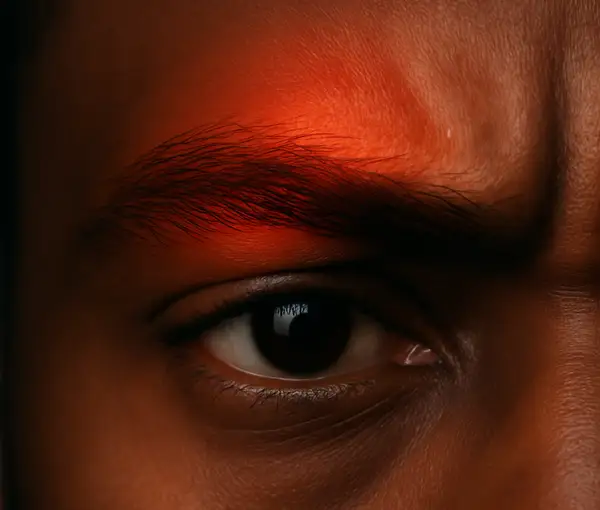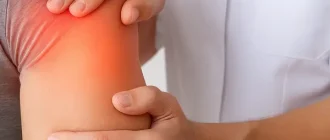Eyebrow twitching is an involuntary muscle movement around the brow, medically known as fasciculation. It often feels like a tiny pulse or flutter under the skin, appearing suddenly and usually without pain. Why is your eyebrow twitching? In most cases, the reason lies in stress, fatigue, or eye strain.
This kind of twitching is similar to the brief flicker of an eyelid that happens after a sleepless night or too much caffeine. The facial muscles are highly sensitive to emotional and physical tension, so even minor imbalances in rest or hydration can trigger these spasms.
When eyebrow twitching happens all the time, it can indicate persistent muscle fatigue, magnesium deficiency, or nervous system irritation. People who spend long hours on screens or experience chronic stress are more prone to such fasciculations, though they usually resolve once the underlying trigger is removed.
Causes
Common Causes
- Stress and fatigue. Emotional or physical tension increases adrenaline, which overstimulates facial nerves.
- Lack of sleep. Missing your regular sleep hours interferes with nerve recovery, causing random twitches.
- Too much caffeine. Over 400 mg daily (about 4 cups of coffee or 1 liter / 34 fl oz of cola) can overstimulate the central nervous system.
- Dehydration and mineral imbalance. Low magnesium or potassium levels interrupt proper nerve signaling.
- Eye strain. Prolonged use of screens leads to muscle overuse near the brow area.
- Allergies or irritation. Rubbing eyes often can irritate local nerves.
A 2023 survey from the American Academy of Ophthalmology found that nearly 62% of adults experience minor eyelid or eyebrow twitching at least once a year ⧉.
Serious Causes
- Facial nerve inflammation (neuritis). Can lead to longer-lasting or painful twitching.
- Benign fasciculation syndrome. A rare but chronic condition involving persistent muscle twitches.
- Multiple sclerosis (MS). Early neurological signs may include recurring eye or brow spasms.
- Brainstem tumors or lesions. Extremely rare but possible, particularly when twitching is one-sided and constant.
Reyus Mammadli, medical consultant, notes that persistent or one-sided twitching that lasts more than two weeks should be checked by a neurologist.
Diagnosis
Physicians start with a clinical exam and review of recent stress levels, diet, and sleep habits. If symptoms persist, diagnostic steps may include:
| Test | Accuracy (1-10) | Average Cost (USD / EUR) |
|---|---|---|
| Blood test | 8 | $60 / €55 |
| MRI | 9 | $800 / €750 |
| EMG (electromyography) | 9 | $250 / €230 |
| EEG | 7 | $300 / €280 |
Below is a breakdown of how these tests work and what to expect during each.
Blood Test
This is usually the first step. A small blood sample from your arm is analyzed to check for mineral imbalances or vitamin deficiencies—like low magnesium or potassium—that can cause nerve misfiring. It’s quick, virtually painless, and results are ready within a few hours.
MRI (Magnetic Resonance Imaging)
MRI creates detailed images of your brain and facial nerves using magnetic fields and radio waves. Think of it as a high-tech camera that looks inside your head without any surgery. You’ll lie still inside a large, open-ended tube for about 20–30 minutes. It’s non-invasive and helps rule out serious causes such as nerve inflammation or lesions ⧉.
EMG (Electromyography)
EMG measures how well your nerves send signals to your muscles. A specialist places tiny electrodes on the skin or inserts fine needles into the muscle to record its activity. The sensation is mild and brief—like a small tap or static shock. Results often clarify whether the twitching comes from a nerve or a muscle issue.
EEG (Electroencephalogram)
This test records electrical activity in the brain. Small sensors are placed on the scalp with a conductive gel, and you simply relax while the computer tracks brain waves. It’s completely painless and useful when twitching is linked to neurological imbalance or stress-induced overactivity.
Together, these tests give a full picture—from nutrient levels to nerve health—helping doctors pinpoint what’s really behind those eyebrow twitches.
Treatments
Natural Methods
Hydration and Rest
Proper hydration supports nerve communication and muscle relaxation. Doctors recommend drinking around 85 fl oz (2.5 L) of water daily. Sleep helps balance neurotransmitters and reduce stress hormones. Many patients notice improvement within 48–72 hours after restoring normal sleep.
Reduce Caffeine
Excess caffeine overstimulates the nervous system. Cutting intake by 50% (for example, from four to two cups of coffee daily) can significantly reduce twitching within 3–5 days. In severe sensitivity cases, decaffeinated alternatives are advised.
Warm Compress and Gentle Massage
Local heat increases blood flow to the affected muscles, helping clear lactic acid buildup and relax nerve endings. Applying a warm compress for 10–15 minutes twice daily and light circular massage are commonly recommended by ophthalmologists ⧉.
Magnesium and Vitamin B12 Supplements
Magnesium supports neuromuscular stability, while vitamin B12 aids in nerve repair. Common medical-grade supplements include magnesium glycinate (200–400 mg daily) and cyanocobalamin (B12, 1000 mcg daily). Improvement is often seen within one to two weeks ⧉.
Screen Breaks and Eye Relaxation
Following the 20-20 rule—looking away from screens every 20 minutes for 20 seconds—reduces strain on the ocular and brow muscles. Blue-light filters or computer glasses can also lower eye tension.
Medical Options
Botulinum Toxin (Botox) Injections
In medical contexts, Botox is used to relieve facial spasms caused by hyperactive nerve impulses—not for cosmetic purposes. A tiny dose (typically 2.5–5 units per injection site) is administered directly into the twitching area. The procedure takes about 10 minutes and starts working within 3–5 days. The relief lasts 3–4 months, after which the procedure may be repeated under medical supervision. Effectiveness: 9/10. Average cost: $350 (€320) per session.
Prescription Muscle Relaxants
Neurologists may prescribe mild muscle relaxants like cyclobenzaprine (5–10 mg) or baclofen (10 mg) for short-term use. These reduce the frequency and strength of involuntary contractions. They are typically used for one to two weeks, as overuse may cause drowsiness.
Anti-inflammatory and Antiviral Medications
In cases involving facial nerve inflammation (neuritis), doctors may prescribe corticosteroids such as prednisone (40–60 mg/day for 5–7 days) to reduce swelling, or antivirals like acyclovir (400 mg 5 times daily) if a viral infection is suspected. These treatments address the root cause rather than symptoms.
Neuromodulation Therapy
This non-invasive technology delivers gentle electrical impulses to the affected nerve area through skin electrodes. Devices such as NexWave or ReBuilder 3000 are commonly used in U.S. physical therapy centers. A typical course includes 8–10 sessions over three weeks, each lasting 20–30 minutes. Patients often experience a gradual reduction in twitch frequency and intensity ⧉.
Real Cases
Case 1: The Overworked Designer (Female, 32, Texas)
A 32-year-old graphic designer from Austin noticed her right eyebrow twitching almost constantly for a week. At first, she brushed it off, blaming long hours in front of her monitor and too much coffee. But as the twitching continued into the tenth day, she started feeling anxious—wondering if it meant something serious.
She visited her primary care physician, who ruled out neurological causes after a brief exam. Her magnesium levels were slightly low, and she was advised to improve her sleep schedule and cut caffeine intake. Within five days of better hydration, using magnesium-rich foods, and going to bed earlier, the twitching completely disappeared. She reported feeling calmer and more focused overall.
Case 2: The Caffeine-Driven Engineer (Male, 45, New York)
A 45-year-old systems engineer from Brooklyn started experiencing random eyebrow spasms during long coding sessions. He consumed 5–6 cups of coffee daily and often skipped lunch. The twitching initially came and went, but after two weeks it became so frequent that colleagues began to notice.
He visited a neurologist, who performed blood tests and an EMG. The results showed no nerve damage, but a mild magnesium deficiency and dehydration were evident. The doctor recommended reducing caffeine, drinking electrolyte water (about 100 fl oz / 3 L daily), and taking magnesium glycinate. Two weeks later, the spasms subsided entirely. He now limits himself to two cups of coffee per day and reports no recurrence after three months ⧉.
Case 3: The Retired Teacher with Nerve Inflammation (Male, 60, California)
A retired schoolteacher from San Diego experienced a sudden, persistent twitch on the left eyebrow that lasted for over three weeks. Unlike mild spasms, this twitching was visible and occasionally accompanied by tingling. Concerned, he visited a neurologist who ordered an MRI and diagnosed mild facial nerve neuritis, likely triggered by a recent viral infection.
He was treated with anti-inflammatory medication, a short course of corticosteroids, and later received a small dose of Botox in the affected area to calm the nerve. Within six weeks, the twitching fully resolved. Follow-up visits showed no recurrence after six months. The patient reported feeling more aware of hydration and daily rest habits, which he now maintains as part of his wellness routine ⧉.
Quick Reference Table
| Trigger | What Happens | Best Fix | Effectiveness (1-10) |
|---|---|---|---|
| Lack of sleep | Fatigued nerve activity | 7–8 hours rest | 8 |
| Caffeine overload | Nerve overstimulation | Reduce intake | 7 |
| Stress | Elevated adrenaline | Relaxation + hydration | 9 |
| Magnesium deficiency | Muscle overactivity | Supplements | 9 |
Editorial Advice
Most eyebrow twitches are harmless and pass within days. Reyus Mammadli, medical consultant, advises that consistent hydration, reduced caffeine, and regular rest are the top prevention strategies. However, if twitching lasts longer than two weeks, or if it’s accompanied by weakness, numbness, or facial drooping, medical evaluation is necessary.
Keeping the body well-rested and properly nourished is the simplest—and most effective—way to keep those brow nerves calm and steady.
About the Author
Reyus Mammadli is the author of this health blog since 2008. With a background in medical and biotechnical devices, he has over 15 years of experience working with medical literature and expert guidelines from WHO, CDC, Mayo Clinic, and others. His goal is to present clear, accurate health information for everyday readers — not as a substitute for medical advice.







